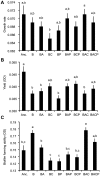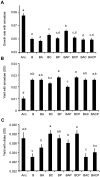Coincidental loss of bacterial virulence in multi-enemy microbial communities
- PMID: 25365586
- PMCID: PMC4218854
- DOI: 10.1371/journal.pone.0111871
Coincidental loss of bacterial virulence in multi-enemy microbial communities
Abstract
The coincidental virulence evolution hypothesis suggests that outside-host selection, such as predation, parasitism and resource competition can indirectly affect the virulence of environmentally-growing bacterial pathogens. While there are some examples of coincidental environmental selection for virulence, it is also possible that the resource acquisition and enemy defence is selecting against it. To test these ideas we conducted an evolutionary experiment by exposing the opportunistic pathogen bacterium Serratia marcescens to the particle-feeding ciliate Tetrahymena thermophila, the surface-feeding amoeba Acanthamoeba castellanii, and the lytic bacteriophage Semad11, in all possible combinations in a simulated pond water environment. After 8 weeks the virulence of the 384 evolved clones were quantified with fruit fly Drosophila melanogaster oral infection model, and several other life-history traits were measured. We found that in comparison to ancestor bacteria, evolutionary treatments reduced the virulence in most of the treatments, but this reduction was not clearly related to any changes in other life-history traits. This suggests that virulence traits do not evolve in close relation with these life-history traits, or that different traits might link to virulence in different selective environments, for example via resource allocation trade-offs.
Conflict of interest statement
Figures






References
-
- Levin BR, Svanborg Eden C (1990) Selection and evolution of virulence in bacteria: an ecumenical excursion and modest suggestion. Parasitology 100 Suppl: S103–115. - PubMed
-
- May RM, Anderson RM (1983) Epidemiology and Genetics in the Coevolution of Parasites and Hosts. P Roy Soc Lond B Bio 219: 281–313. - PubMed
Publication types
MeSH terms
Substances
LinkOut - more resources
Full Text Sources
Other Literature Sources

